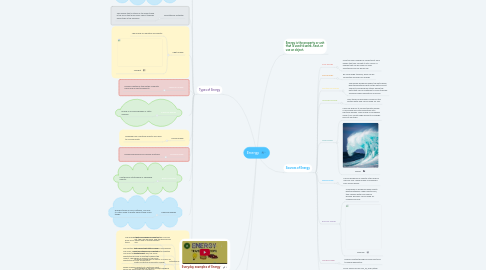
1. Types of Energy
1.1. Thermal Energy
1.1.1. The energy contained in heat.
1.2. Kinetic Energy
1.2.1. The energy in moving objects or movement objects.
1.2.2. Kinetic Energy = 1/2 x mass x velocity2
1.2.3. The two factors that impact Kinetic energy are mass and velocity. If there is more mass the kinetic energy increases. If there is more velocity that an object is travelling at, the more kinetic energy there is since there is more force required to make the object accelerate at a higher speed. Also you need more energy to exert more force on an object.
1.2.4. Examples of Kinetic energy in everyday uses are: Airplanes, Cars, Skies, Insect, Baseball. All of these examples have a change in mass or velocity.
1.3. Gravitational Potential
1.3.1. The energy that is stored in tall objects and is the force that pulls every object towards each other in the universe.
1.4. Light Energy
1.4.1. The energy of radiation and gravity.
1.4.2. Sunlight
1.5. Magnetic Energy
1.5.1. Energy created by the earth's magnetic fields and in electromagnets.
1.6. Electrical Energy
1.6.1. Energy in moving charges or static charges.
1.7. Sound Energy
1.7.1. Released from vibrating objects and used to communicate.
1.8. Nuclear Energy
1.8.1. Energy produced from nuclear reactions.
1.9. Elastic Potential
1.9.1. Contained in stretchable or squashed objects.
1.10. Chemical Energy
1.10.1. Energy stored in food, batteries, and fuel. It's often used to power objects and living things.
1.11. Potential Energy
1.11.1. The energy that is possessed inside the body of an object and it stresses within itself.
1.11.2. The factors that impact Potential Energy are mass, height, and the force of gravity. The more mass an object has, the more gravitational force is exerted towards the object. The higher an object is, the more gravitational force surrounds it.
1.11.3. When charged objects at a distance exert forces on each other can transfer to objects interacting with the charged objects.
1.11.4. The forces that exist in between the two objects possessed with energy are gravity, friction, internal force, and frictional force.
2. Everyday examples of Energy
2.1. Chemical energy is found in the food we eat, the cars we drive, and the devices we use.
2.2. Thermal energy that is used in microwaves is when energy is converted into radiation to heat food.
2.3. An elastic being shot in the air is a form of elastic potential and kinetic energy.
2.4. The charges in the wall socket charging your device is a form of electrical charges being used as energy.
3. Sources
3.1. BBC - GCSE Bitesize: Forms of energy
3.2. What is energy?
3.3. Energy Transformations Examples
4. Energy is the property or unit that is used to work, heat, or use an object.
5. Sources of Energy
5.1. Solar Energy
5.1.1. Uses the sun's energy by collecting it from panels that can convert it into a form of energy that can be used for small substances and for home use.
5.2. Wind Energy
5.2.1. By using large turbines, wind can be converted and used for energy.
5.3. Geothermal Energy
5.3.1. The energy produced under the earth when high temperatures heat up the earth's crust. The hot rocks produce steam above the earth that can be captured to move turbines. Turbines power generators in homes.
5.4. Hydrogen Energy
5.4.1. Two-thirds of hydrogen is found in the earth's water and can be used for fuel.
5.5. Tidal Energy
5.5.1. Uses rise and fall to convert kinetic energy of incoming and outcoming tides into electrical energy. Tidal energy is renewable since it can create large amounts of energy even at low tides.
5.5.2. Waves
5.6. Wave Energy
5.6.1. Can be produced in coastal cities and be used for fuel. Wave energy is produced from ocean waves.
5.7. Biomass Energy
5.7.1. Chlorophyll is produced when plants photosynthesize. When plants burn, they release water and carbon dioxide. Biomass can be used for cooking and fuel.
5.7.2. Biomass
5.8. Nuclear Power
5.8.1. Energy created through nuclear reactions to power generators.
5.9. Fossil Energy
5.9.1. Fossil fuels such as coal, oil, and natural gas can be found beneath the earth's surface. They can be used for fuel and to produce electricity in homes.

